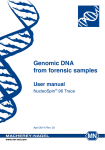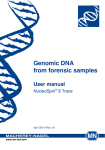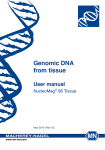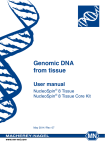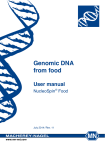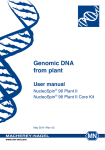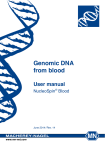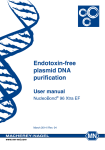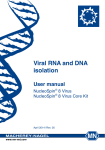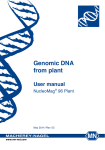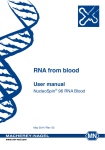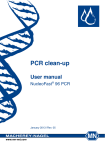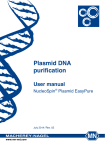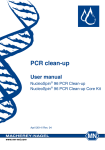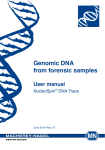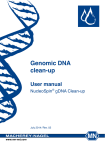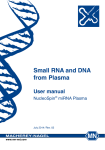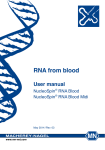Download NucleoSpin® 96 Tissue - MACHEREY
Transcript
Genomic DNA from tissue User manual NucleoSpin® 96 Tissue NucleoSpin® 96 Tissue Core Kit May 2014 / Rev. 07 Genomic DNA from tissue Table of contents 1 Components 4 1.1 Kit contents 4 1.2 Reagents to be supplied by user 5 2 Product description 6 2.1 The basic principle 6 2.2 Kit specifications 6 2.3 Required hardware 7 2.4 Accessories supplied for use of the NucleoSpin® 96 Tissue Core Kit 8 2.5 Automated processing on robotic platforms 10 2.6 Elution procedures 10 3 Storage conditions and preparation of working solutions 12 4 Safety instructions 14 5Protocols 16 ® 16 ® 21 5.1NucleoSpin 96 Tissue – centrifuge processing 5.2NucleoSpin 96 Tissue – vacuum processing 6Appendix 28 6.1Troubleshooting 28 6.2 Ordering information 30 6.3 Product use restriction / warranty 31 MACHEREY-NAGEL – 05 / 2014, Rev. 07 3 Genomic DNA from tissue 1 Components 1.1 Kit contents NucleoSpin® 96 Tissue 2 x 96 preps 4 x 96 preps 24 x 96 preps 740741.2 740741.4 740741.241 50 mL 100 mL 6 x 100 mL 50 mL 100 mL 6 x 100 mL 100 mL 2 x 100 mL 12 x 100 mL Wash Buffer BW 125 mL 2 x 125 mL 12 x 125 mL Elution Buffer BE3 60 mL 125 mL 6 x 125 mL 2 x 75 mg 4 x 75 mg 24 x 75 mg 8 mL 15 mL 6 x 15 mL NucleoSpin Tissue Binding Plates (green rings) 2 4 24 Round-well Blocks4 2 4 24 MN Square-well Blocks 2 4 24 2 4 24 Rack of Tube Strips6 2 4 24 Cap Strips 24 48 288 Self-adhering PE Foil 5 10 60 User manual 1 1 6 REF Lysis Buffer T1 Binding Buffer BQ1 Wash Buffer B5 (Concentrate) 2 Proteinase K (lyophilized)2 Proteinase Buffer PB ® MN Wash Plates 1 2 3 4 5 6 5 The kit for 24 x 96 preparations (REF 740741.24) consists of 6 x REF 740741.4. For preparation of working solutions and storage conditions, see section 3. Elution Buffer BE: 5 mM Tris/HCl, pH 8.5 Including 12 Cap Strips for each block For use with vacuum only Sets of 1 rack, 12 strips with 8 tubes each, including Cap Strips 4 MACHEREY-NAGEL – 05 / 2014, Rev. 07 Genomic DNA from tissue 1.1 Kit contents continued NucleoSpin® 96 Tissue Core Kit 4 x 96 preps REF 740454.4 Lysis Buffer T1 100 mL Binding Buffer BQ1 100 mL Wash Buffer B5 (Concentrate)1 2 x 100 mL Wash Buffer BW 2 x 125 mL Elution Buffer BE2 125 mL Proteinase K (lyophilized)1 4 x 75 mg Proteinase Buffer PB 15 mL NucleoSpin® Tissue Binding Plates (green rings) 4 User manual 1 1.2 Reagents to be supplied by user • 96–100% ethanol (for preparation of working solutions; see section 3) For more detailed information regarding special hardware required for centrifuge or vacuum processing, please see section 2.3. For recommended accessories for use of the flexible NucleoSpin® 96 Tissue Core Kit (reduced kit composition; REF 740454.4), please see section 2.4. 1 2 For preparation of working solutions and storage conditions see section 3. Elution Buffer BE: 5 mM Tris/HCl, pH 8.5 MACHEREY-NAGEL – 05 / 2014, Rev. 07 5 Genomic DNA from tissue 2 Product description 2.1 The basic principle The NucleoSpin® 96 Tissue kit is designed for the efficient isolation of high molecular weight genomic DNA from tissue samples or cells. With the NucleoSpin® 96 Tissue procedure, sample lysis is achieved by incubation of the samples in a solution containing SDS and Proteinase K. Appropriate conditions for binding of DNA to the silica membrane in the NucleoSpin® Tissue Binding Plate are created by addition of large amounts of chaotropic salt and ethanol to the lysate. The binding process is reversible and specific to nucleic acids. While DNA is kept on the silica membrane, contaminations are removed by washing with two different wash buffers. Pure genomic DNA is finally eluted under low ionic strength conditions in a slightly alkaline elution buffer. 2.2 Kit specifications 6 • NucleoSpin® 96 Tissue is designed for the rapid preparation of highly pure genomic DNA from tissue, for example, mouse and rat tails, organ tissue, or animal or bacterial cells. The purified DNA can be used directly as template for PCR, blotting, or any kind of enzymatic reactions. • This kit provides reagents and consumables for purification of up to 40 μg (average 20 μg) of pure genomic DNA from up to 20 mg tissue samples with an A260 / A280 ratio between 1.8 and 1.9 and a typical concentration of 100– 200 ng/μL. • From up to two 0.5 cm long mouse tail tip section (age of mice: 4–6 weeks), up to 35 μg of pure genomic DNA can be prepared (typical yields: 15–25 μg). • NucleoSpin® 96 Tissue can be processed by vacuum or in a centrifuge. The kit allow easy automation on common liquid handling instruments. • The NucleoSpin® 96 Tissue kits allow for the purification of multiples of 96 samples. The kits are supplied with accessory plates for highest convenience. The kits are designed for manual or automated use in a centrifuge or for use with a vacuum manifold. The NucleoSpin® 96 Tissue Core Kit provides the buffers, Proteinase K and NucleoSpin® Tissue Binding Plate only. Accessory components (e.g., lysis plates, elution plates) are not provided with the core kit but can be individually selected from a variety of suitable accessories (see section 2.4 for further information). This allows highest flexibility for the user. MACHEREY-NAGEL – 05 / 2014, Rev. 07 Genomic DNA from tissue Kit specifications at a glance NucleoSpin® 96 Tissue Parameter Format Processing Sample material 96-well plates Manual and automated, vacuum or centrifugation Up to 20 mg tissue, up to 106 cultured cells, bacteria Typical yield 15–25 μg A260/A280 1.8–1.9 Elution volume 100–200 μL Preparation time 60 min/plate (excl. lysis) Binding capacity 40 μg 2.3 Required hardware NucleoSpin® 96 Tissue can be processed under vacuum or with centrifugation. Certain hardware for processing is required. Centrifugation For centrifugation, a microtiterplate centrifuge is required. This centrifuge must be able to accomodate the NucleoSpin® Tissue Binding Plate stacked on a Round- or Squarewell Block and reach accelerations of 5,600–6,000 x g is required (bucket height: 85 mm). Regarding waste collection, suitable consumables (e.g., MN Square-well Blocks) are necessary and they are not included in the kit. For the most convenient handling, without the need of emptying and reusing the MN Square-well Blocks, we recommend using six MN Square-well Blocks if two 96-well plates are processed at once (see ordering information). Alternatively, it is possible to empty the MN Square-well Blocks after every centrifugation step, reducing the amount of MN Square-well Blocks needed. Vacuum processing The NucleoSpin® 96 Tissue kit can be used with the NucleoVac 96 Vacuum Manifold (see ordering information). When using NucleoSpin® 96 Tissue with less than 96 samples, Self-adhering PE Foil (see ordering information) should be used in order to close and protect non-used wells of the NucleoSpin® Tissue Binding Plate and thus guarantee proper vacuum. Establish a reliable vacuum source for the NucleoVac 96 Vacuum Manifold. The manifold may be used with a vacuum pump, house vacuum, or water aspirator. We recommend a vacuum of -0.2 to -0.4 bar (reduction of atmospheric pressure). The use of the NucleoVac Vacuum Regulator (see ordering information) is recommended. MACHEREY-NAGEL – 05 / 2014, Rev. 07 7 Genomic DNA from tissue Alternatively, adjust the vacuum so that during the purification the sample flows through the column with a rate of 1–2 drops per second. Depending on the amount of sample being used, the vacuum times may need to be increased for complete filtration. Additionally, a suitable centrifuge for sample preparation steps may be required. For general consumables and equipment needed, please see section 1.2. 2.4 Accessories supplied for use of the NucleoSpin® 96 Tissue Core Kit The NucleoSpin® 96 Tissue Core Kit provides buffers, Proteinase K, and NucleoSpin® Tissue Binding Plates. Accessory plates (e.g., lysis plates, elution plates) are not provided with the core kit. The reduced kit composition along with a variety of separately available accessories, allow optimal adjustment of the kit to individual user needs. The user can select additional consumables according to his / her requirements for highest flexibility. For use of NucleoSpin® 96 Tissue Core Kit, follow the standard protocols (see section 5.1 and 5.2). Recommended accessories for use of the NucleoSpin® 96 Tissue Core Kit are available from MACHEREY-NAGEL (see ordering information). Protocol step Suitable consumables, not supplied with the core kits Remarks Lyse samples 4 x Round-well Block with Cap Strips per 4 x 96 preps For sample lysis or 4 x Rack of Tube Strips with Cap Strips per 4 x 96 preps 8 MACHEREY-NAGEL – 05 / 2014, Rev. 07 Genomic DNA from tissue Protocol step Suitable consumables, not supplied with the core kits Remarks Adjust binding conditions 48 x Cap Strips per 4 x 96 preps When using Round-well Block or Tube Strips for lysis, new Cap Strips are required for sealing of wells after adding Buffer BQ1 and ethanol. 4 x MN Squarewell Block per 4 x 96 preps Recommended for automated processing only 4 x MN Wash Plate per 4 x 96 preps MN Wash Plate minimizes the risk of cross contamination (vacuum processing only). 2 x MN Squarewell Block For waste collection during centrifugation (reusable) Bind DNA to the membrane Elute DNA 4 x Rack of Tubes Strips with Cap Strips per 4 x 96 preps or 4 x Round-well Block with Cap Strips per 4 x 96 preps MACHEREY-NAGEL – 05 / 2014, Rev. 07 9 Genomic DNA from tissue 2.5 Automated processing on robotic platforms NucleoSpin® 96 Tissue can be used fully automated on many common laboratory workstations. For the availability of scripts and general considerations about adapting NucleoSpin® 96 Tissue on a certain workstation, please contact MN. Full processing under vacuum enables complete automation without the need for centrifugation steps for drying of the binding membrane or for elution. However, a final elution step by centrifugation is recommended in order to achieve higher concentrated eluted DNA. The risk of cross-contamination is reduced by optimized vacuum settings during the elution step and by the improved shape of the outlets of the NucleoSpin® Tissue Binding Plate. Drying of the NucleoSpin® Tissue Binding Plates under vacuum is sufficient because the bottom of the plate is protected by the MN Wash Plate during the washing steps. As a result, it is recommended to integrate the MN Wash Plate into the automated procedure to protect against these wash buffer residues. The MN Frame (see ordering information) can be used to position the disposable MN Wash Plate inside the vacuum chamber. This also reduces the risk of cross-contamination, as common metal adaptors tend to get contaminated by gDNA. Thorough cleaning of the vacuum chamber is recommended after each run to prevent DNA-containing aerosols from forming. Visit MN online at www.mn-net.com or contact your local MACHEREY-NAGEL distributor for technical support regarding hardware, software, setup instructions, and selection of the protocol. Several application notes of the NucleoSpin® 96 Tissue kit on various liquid handling instruments can also be found at www.mn-net.com at Bioanalysis / Literature. 2.6 Elution procedures It is possible to adjust the elution method and the volume of the elution buffer to the subsequent application of interest. In addition, to the standard method described in the protocols (recovery rate about 70–90 %) there are several modifications possible. Use elution buffer preheated at 70 °C for one of the following procedures: 10 • High yield: Perform two elution steps with the volume indicated in the individual protocol. About 90–100 % of bound nucleic acids can be eluted. • High concentration: Perform one elution step with only 60 % of the volume indicated in the individual protocol. Concentration of DNA will be about 30 % higher than with the standard elution procedure. Maximum yield of bound nucleic acids is about 80 %. • High yield and high concentration: Apply half the volume of elution buffer as indicated in the individual protocol, incubate for 3 min and centrifuge. Apply a second aliquot of elution buffer, incubate and centrifuge again. Thus, about 85–100 % of bound nucleic acids are eluted in the standard elution volume at a high concentration. MACHEREY-NAGEL – 05 / 2014, Rev. 07 Genomic DNA from tissue • Convenient elution: For convenience, elution buffer of ambient temperature may be used. This will result in a slightly lower yield (approximately 20 %) compared to elution with heated elution buffer. Elution may also be performed with Tris-EDTA-buffer (TE) of pH equal or higher than 8. This will increase DNA stability during long term or multi-use storage at 4 °C (or ambient temperature) by inhibiting omnipresent DNases. However, EDTA interferes, depending on the final concentration, with certain downstream applications. For optimal performance of isolated DNA in downstream applications, we recommend eluting with the supplied elution buffer and storing it, especially long term, at - 20 °C. Several freeze-thaw cycles will not interfere with most downstream applications. Performance of long-range PCR (e.g., > 10 kb) or the detection limit of trace amount of DNA species, may be reduced after multiple freeze-thaw cycles or prolonged storage of eluted DNA at 4 °C or room temperature. This is due to shearing of DNA or adsorption to surfaces. Due to the dead volume of the silica membrane, please note that the difference between the dispensed elution buffer volume and the recovered elution buffer volume containing genomic DNA is approximately 20 μL (recovered elution volume = dispensed elution volume - 20 μL). MACHEREY-NAGEL – 05 / 2014, Rev. 07 11 Genomic DNA from tissue 3 Storage conditions and preparation of working solutions Attention: Buffer BQ1 and BW contain chaotropic salts. Wear gloves and goggles! CAUTION: Buffers BQ1 and BW contain guanidine hydrochloride which can form highly reactive compounds when combined with bleach (sodium hypochlorite). DO NOT add bleach or acidic solutions directly to the sample-preparation waste. Storage conditions: • All components of the NucleoSpin® 96 Tissue kits should be stored at room temperature (18–25 °C) for a maximum of 1 year. Storage at lower temperatures may cause precipitation of salts. If a salt precipitation is observed, incubate the bottle at 30–40 °C for some minutes and mix well until all of the precipitate is redissolved. The performance of the kits is not affected by the salt precipitates. Before starting any NucleoSpin® 96 Tissue protocol, prepare the following: • Wash Buffer B5: Add the indicated volume of ethanol (96–100 %) to Buffer B5 Concentrate before use. Mark the label of the bottle to indicate that ethanol was added. Store Wash Buffer B5 at room temperature (18–25 °C) for up to one year. • Before first use of the kit, add the indicated volume of Proteinase Buffer PB to lyophilized Proteinase K. Proteinase K solution is stable at - 20 °C for up to 6 months. NucleoSpin® 96 Tissue 2 x 96 preps 4 x 96 preps 24 x 96 preps 740741.2 740741.4 740741.24 Wash Buffer B5 (Concentrate) 100 mL Add 400 mL ethanol 2 x 100 mL Add 400 mL ethanol to each bottle 12 x 100 mL Add 400 mL ethanol to each bottle Proteinase K (lyophilized) 2 x 75 mg 4 x 75 mg 24 x 75 mg Add 2.6 mL Add 2.6 mL Add 2.6 mL Proteinase Buffer PB Proteinase Buffer PB Proteinase Buffer PB to each vial to each vial to each vial REF 12 MACHEREY-NAGEL – 05 / 2014, Rev. 07 Genomic DNA from tissue NucleoSpin® 96 Tissue Core Kit 4 x 96 preps REF Wash Buffer B5 (Concentrate) Proteinase K (lyophilized) 740454.4 2 x 100 mL Add 400 mL ethanol to each bottle 4 x 75 mg Add 2.6 mL Proteinase Buffer to each vial MACHEREY-NAGEL – 05 / 2014, Rev. 07 13 Genomic DNA from tissue 4 Safety instructions The following components of the NucleoSpin® 96 Tissue and NucleoSpin® 96 Tissue Core kits contain hazardous contents. Wear gloves and goggles and follow the safety instructions given in this section. GHS classification Only harmful features need not be labeled with H and P phrases until 125 mL or 125 g. Mindergefährliche Eigenschaften müssen bis 125 mL oder 125 g nicht mit H- und P-Sätzen gekennzeichnet werden. Component Hazard contents GHS symbol Hazard Precaution phrases phrases Inhalt Gefahrstoff GHS Symbol H-Sätze P-Sätze BQ1 Guanidine hydrochloride 50–66 % Warning Guanidinhydrochlorid 50–66 % Achtung 302, 315, 319 280, 301+312, 302+352, 305+351+338, 330, 332+313, 337+313 Guanidine hydrochloride 36–50 % + isopropanol 20–50 % Warning 226, 302, 319 210, 233, 280, 301+312, 305+351+338, 330, 337+313, 403+235 315, 319, 334, 335 261, 280, 302+352, 304+340, 305+351+338, 312, 332+313, 337+313, 342+311, 403+233 BW Proteinase K Guanidinhydrochlorid 36–50 % + Isopropanol 20–50 % Achtung Proteinase K, lyophilized Danger Proteinase K, lyophilisiert Gefahr Hazard phrases H 226 Flammable liquid and vapour. H 302 Harmful if swallowed. H 315 Causes skin irritation. H 319 Causes serious eye irritation. H 334 May cause allergy or asthma symptoms or breathing difficulties if inhaled. 14 Flüssigkeit und Dampf entzündbar. Gesundheitsschädlich bei Verschlucken. Verursacht Hautreizungen. Verursacht schwere Augenreizung. Kann bei Einatmen Allergie, asthmaartige Symptome oder Atembeschwerden verursachen. MACHEREY-NAGEL – 05 / 2014, Rev. 07 Genomic DNA from tissue Hazard phrases H 335 May cause respiratory irritation. Kann die Atemwege reizen. Precaution phrases P 210 Keep away from heat, hot surfaces, sparks, open flames and other ignition sources. No smoking. Von Hitze, heißen Oberflächen, Funken, offenen Flammen sowie anderen Zündquellenarten fernhalten. Nicht rauchen. P 233 Keep container tightly closed. P 261 Avoid breathing dust. P 280 Wear protective gloves / eye protection. P 301+312 IF SWALLOWED: Call a POISON CENTER/ doctor/…/if you feel unwell. P 302+352 IF ON SKIN: Wash with plenty of water/… P 304+340 IF INHALED: Remove victim to fresh air and keep at rest in a position comfortable for breathing. Behälter dicht verschlossen halten. Einatmen von Staub vermeiden. Schutzhandschuhe / Augenschutz tragen. BEI VERSCHLUCKEN: Bei Unwohlsein GIFTINFORMATIONSZENTRUM / Arzt /… anrufen. BEI KONTAKT MIT DER HAUT: Mit viel Wasser/… waschen. BEI EINATMEN: An die frische Luft bringen und in einer Position ruhigstellen, die das Atmen erleichtert. P 305+351+338 IF IN EYES: Rinse continuously with water for several minutes. Remove contact lenses if present and easy to do – continue rinsing. BEI KONTAKT MIT DEN AUGEN: Einige Minuten lang behutsam mit Wasser spülen. Vorhandene Kontaktlinsen nach Möglichkeit entfernen. Weiter spülen. P 312 Call a POISON CENTER/ doctor/…/if you feel unwell. P 330 Rinse mouth. P 332+313 If skin irritation occurs: Get medical advice / attention. P 337+313 Get medical advice / attention. P 342+311 If experiencing respiratory symptoms: Call a POISON CENTER/ doctor/… P 403+233 Store in a well ventilated place. Keep container tightly closed. P 403+235 Store in a well ventilated place. Keep cool. Bei Unwohlsein GIFTINFORMATIONSZENTRUM / Arzt /… anrufen. Mund ausspülen. Bei Hautreizung: Ärztlichen Rat einholen / ärztliche Hilfe hinzuziehen. Bei anhaltender Augenreizung: Ärztlichen Rat einholen / ärztliche Hilfe hinzuziehen. Bei Symptomen der Atemwege: GIFTINFORMATIONSZENTRUM /Arzt/… anrufen. Behälter dicht geschlossen an einem gut belüfteten Ort aufbewahren. Kühl an einem gut belüfteten Ort aufbewahren. For further information please see Material Safety Data Sheets (www.mn-net.com). Weiterführende Informationen finden Sie in den Sicherheitsdatenblättern (www.mn-net.com). MACHEREY-NAGEL – 05 / 2014, Rev. 07 15 NucleoSpin® 96 Tissue – centrifuge processing 5 Protocols 5.1 NucleoSpin® 96 Tissue – centrifuge processing • For hardware requirements, refer to section 2.3. • For use of the NucleoSpin® 96 Tissue Core Kit (REF 740454.4), refer to section 2.4 regarding recommended accessories. • For detailed information on each step, see page 21. Before starting the preparation: • • • Check if Buffer B5 and Proteinase K were prepared according to section 3. Set incubator or oven to 56 °C. Preheat Elution Buffer BE to 70 °C. Protocol-at-a-glance 1 Prepare samples 2 Lyse samples 2 x 0.5 cm mouse tail or up to 20 mg tissue, 106 cultured cells, or bacteria 180 μL T1 25 μL Proteinase K Mix 56 °C, ≥ 6 h 3 Adjust DNA binding conditions 200 μL BQ1 200 μL ethanol (96–100 %) Mix 4 Transfer lysates to NucleoSpin® Tissue Binding Plate 5 Bind DNA to silica membrane of the NucleoSpin® Tissue Binding Plate 16 5,600 x g, 10 min MACHEREY-NAGEL – 05 / 2014, Rev. 07 NucleoSpin® 96 Tissue – centrifuge processing 6 Wash silica membrane 500 μL BW 5,600 x g, 2 min 700 μL B5 5,600 x g, 4 min 7 Dry silica membrane 8 Elute DNA 70°C, 10 min 100 μL BE (70 °C) 5,600 x g, 2 min Optional: Repeat elution step once. MACHEREY-NAGEL – 05 / 2014, Rev. 07 17 NucleoSpin® 96 Tissue – centrifuge processing Detailed protocol • • For hardware requirements, refer to section 2.3. For use of the NucleoSpin® 96 Tissue Core Kit (REF 740454.4), refer to section 2.4 regarding recommended accessories. Before starting the preparation: • • • 1 Check if Buffer B5 and Proteinase K were prepared according to section 3. Set incubator or oven to 56 °C. Preheat Elution Buffer BE to 70 °C. Prepare samples For each preparation, cut up to two 0.5 cm pieces (20 mg) of mouse tail into appropriate lysis tubes or plates. If preparing DNA from rat tails, one 0.5 cm piece is sufficient. Tissue samples should not exceed 20 mg, cultured cells and bacteria should not exceed 106 cells. 2 Lyse samples Prepare a Proteinase K working solution: For each sample, mix 25 μL Proteinase K with 180 μL Buffer T1 and vortex. Transfer 200 μL of the resulting solution to each well of the Round-well Block containing the samples. Close the wells with Cap Strips. Mix by vigorous shaking for 10–15 s. Spin briefly (15 s; 1,500 x g) to collect any sample at the bottom of the wells. The samples must be submerged in the solution. Never prepare the Proteinase K working solution more than 15 min before addition to the samples. Proteinase K tends to self digestion when incubated in Buffer T1 without substrate. Incubate the Round-well Block containing the samples at 56 °C for at least 6 h (for mammalian cells reduce incubation to 10 min, bacterial cells may require pre-lysis with, e.g., lysozyme) or overnight until the samples are completely lysed. For optimal lysis, mix occasionally during incubation. Place a weight on top of the Round-well Block in order to prevent the Cap Strips from popping off occasionally. After lysis, set the incubator to 70 °C for the membrane drying step. Centrifuge the Round-well Block (15 s; 1,500 x g) to collect any condensate from the Cap Strips. Remove Cap Strips. Residual hair and / or bones in the lysate can be removed by centrifugation (2 min; 5,600–6,000 x g) and transfer of the supernatant to a new Round-well Block (not supplied with the kit). 18 MACHEREY-NAGEL – 05 / 2014, Rev. 07 NucleoSpin® 96 Tissue – centrifuge processing 3 Adjust DNA binding conditions Add 200 μL Buffer BQ1 and 200 μL 96–100 % ethanol to each sample. Again, take care not to moisten the rims of the individual wells while dispensing the buffer. Close the individual wells with new Cap Strips (supplied). Mix by vigorous shaking for 10–15 s. Spin briefly (10 s; 1,500 x g) to collect any sample from the Cap Strips. Ethanol and Buffer BQ1 can be premixed before addition to the samples, if the mixture is to be used during the next 3 months. Never centrifuge at higher g-forces or for longer periods as DNA will precipitate. Place a NucleoSpin® Tissue Binding Plate on a MN Square-well Block. If using more than one plate, label the plates for later identification. The use of a second plate placed on a MN Square-well Block avoids the need to balance the centrifuge. 4 Transfer lysates Remove the first Cap Strip and transfer the lysates resulting from step 2 carefully from the Round-well Block into the wells of the NucleoSpin® Tissue Binding Plate. Continue with the next eight samples. Do not moisten the rims of the individual wells while dispensing the samples – moistened rims may cause cross contamination during centrifugation. After transfer, seal the openings of the plate with Self-adhering PE Foil. For transfer of the lysate from the Round-well Block to the NucleoSpin® Tissue Binding Plate, we recommend use of an electronic eight-channel pipetting device with extra long tips capable of holding more than 650 μL. 5 Bind DNA to silica membrane Place the MN Square-well Blocks with NucleoSpin® Tissue Binding Plates onto the centrifuge carriers and insert them into the rotor buckets. Centrifuge at 5,600–6,000 x g for 10 min. Typically, the lysates will have passed through the silica membrane within a few minutes. The centrifugation process can be extended to 20 min, if the lysates have not passed completely. MACHEREY-NAGEL – 05 / 2014, Rev. 07 19 NucleoSpin® 96 Tissue – centrifuge processing 6 Wash silica membrane 1st wash Remove the Self-adhering PE Foil and add 500 μL Buffer BW to each well of the NucleoSpin® Tissue Binding Plate. Seal the plate with a new Self-adhering PE Foil and centrifuge again at 5,600–6,000 x g for 2 min. 2nd wash Remove the Self-adhering PE Foil and add 700 μL Buffer B5 to each well of the NucleoSpin® Tissue Binding Plate. Seal the plate with a new Self-adhering PE Foil and centrifuge again at 5,600–6,000 x g for 4 min. During this step, as much ethanolic Buffer B5 as possible is removed by centrifugation. 7 Dry silica membrane Remove the Self-adhering PE Foil and place the NucleoSpin® Tissue Binding Plate on an opened Rack of Tube Strips. Place it in an incubator for 10 min at 70 °C to evaporate residual ethanol. Removal of ethanol by evaporation at 70 °C is more effective than prolonged centrifugation. Note: The ethanol in Buffer B5 may inhibit enzymatic reactions and should be removed completely before eluting DNA. 8 Elute DNA Dispense 100 μL preheated Buffer BE (70 °C) to each well of the NucleoSpin® Tissue Binding Plate. Dispense the buffer directly onto the membrane. Incubate at room temperature for 1 min. Centrifuge at 5,600–6,000 x g for 2 min. Repeat elution step once. Remove the NucleoSpin® Tissue Binding Plate from the Rack of Tube Strips by lifting the plate at one side carefully as the Tube Strips may stick to the outlets of the NucleoSpin® Tissue Binding Plate. For alternative elution procedures see section 2.3. If elution in small volume tubes is desired, place a 96 PCR plate (not supplied) on top of a Round-well Block or a Rack of Tube Strips and elute into the PCR plate. 20 MACHEREY-NAGEL – 05 / 2014, Rev. 07 NucleoSpin® 96 Tissue – vacuum processing 5.2 NucleoSpin® 96 Tissue – vacuum processing • For hardware requirements, refer to section 2.3. • For detailed information on each step, see page 27. • • For detailed information regarding the vacuum manifold setup, see page 26. For use of the NucleoSpin® 96 Tissue Core Kit (REF 740454.4), refer to section 2.4 regarding recommended accessories. Before starting the preparation: • • • Check if Buffer B5 and Proteinase K were prepared according to section 3. Set incubator or oven to 56 °C. Preheat Elution Buffer BE to 70 °C. Protocol-at-a-glance 1 Prepare samples 2 Lyse samples 2 x 0.5 cm mouse tail or up to 20 mg tissue, 106 cultured cells, or bacteria 180 μL T1 25 μL Proteinase K Mix 56 °C, ≥ 6 h 3 Adjust DNA binding conditions 200 μL BQ1 200 μL ethanol (96–100 %) Mix Prepare the NucleoVac 96 Vacuum Manifold 4 Transfer lysates to NucleoSpin® Tissue Binding Plate 5 Bind DNA to silica membrane of the NucleoSpin® Tissue Binding Plate -0.2 bar*, 5 min * Reduction of atmospheric pressure MACHEREY-NAGEL – 05 / 2014, Rev. 07 21 NucleoSpin® 96 Tissue – vacuum processing 6 Wash silica membrane 600 μL BW 900 μL B5 900 μL B5 -0.2 bar*, 5 min each step Remove MN Wash Plate 7 Dry silica membrane 8 Elute DNA - 0.6 bar*, 10 min 100 μL BE (70 °C) -0.4 bar*, 2 min Optional: Repeat elution step once * Reduction of atmospheric pressure 22 MACHEREY-NAGEL – 05 / 2014, Rev. 07 NucleoSpin® 96 Tissue – vacuum processing Setup of vacuum manifold: Binding / Washing steps Elution step Step 4: Place the NucleoSpin® Binding Plate on top of the manifold lid. Step 4: Place the NucleoSpin® Binding Plate on top of the manifold lid. Step 3: Place the manifold lid on top of the manifold base. Step 3: Place the manifold lid on top of the manifold base. Step 2: Place the MN Wash Plate in the manifold. Step 2: Place the Rack of Tube Strips in the manifold. MICR OT Step 1: Insert spacers ‘MTP/MULTI-96 PLATE‘ and waste container in the manifold base. MICR OT UB UB E RA E RA CK Final setup CK Step 1: Insert spacers ‘MICROTUBE RACK‘ in the manifold base. Final setup MICR OT MICR OT UB UB E RA CK E RA CK MACHEREY-NAGEL – 05 / 2014, Rev. 07 23 NucleoSpin® 96 Tissue – vacuum processing Detailed protocol • For hardware requirements, refer to section 2.3. • For use of the NucleoSpin® 96 Tissue Core Kit (REF 740454.4), refer to section 2.4 regarding recommended accessories. • For detailed information regarding the vacuum manifold setup, see page 26. Before starting the preparation: • • • 1 Check if Buffer B5 and Proteinase K were prepared according to section 3. Set incubator or oven to 56 °C. Preheat Elution Buffer BE to 70 °C. Prepare samples For each preparation, cut up to two 0.5 cm pieces (20 mg) of mouse tail into appropriate lysis tubes or plates. If preparing DNA from rat tails, one 0.5 cm piece is sufficient. Tissue samples should not exceed 20 mg, cultured cells and bacteria should not exceed 106 cells. 2 Lyse samples Prepare a Proteinase K working solution: For each sample, mix 25 μL Proteinase K with 180 μL Buffer T1 and vortex. Transfer 200 μL of the resulting solution to each well of the Round-well Block containing the samples. Close the wells with Cap Strips and mix by vigorous shaking for 10–15 s. Spin briefly (15 s; 1,500 x g) to collect any sample at the bottom of the wells. The samples must be submerged in the solution. Never prepare the Proteinase K working solution more than 15 min before addition to the samples. Proteinase K tends to self digestion when incubated in Buffer T1 without substrate. Incubate the Round-well Block containing the samples at 56°C for at least 6 h (for mammalian cells reduce incubation to 10 min, bacterial cells may require pre-lysis with, e.g., lysozyme) or overnight until the samples are completely lysed. For optimal lysis, mix occasionally during incubation. Place a weight on top of the Round-well Block in order to prevent the Cap Strips from popping off occasionally. Centrifuge the Round-well Block (15 s; 1,500 x g) to collect any condensate from the Cap Strips. Remove Cap Strips. Residual hair and / or bones in the lysate can be removed by centrifugation (2 min; 5,600 –6,000 x g) and transfer of the supernatant to a new Round-well Block (not supplied with the kit). 24 MACHEREY-NAGEL – 05 / 2014, Rev. 07 NucleoSpin® 96 Tissue – vacuum processing 3 Adjust DNA binding conditions Add 200 μL Buffer BQ1 and 200 μL 96–100 % ethanol to each sample. Again, take care not to moisten the rims of the individual wells while dispensing the buffer. Close the individual wells with new Cap Strips (supplied). Mix by vigorous shaking for 10–15 s. Spin briefly (10 s; 1,500 x g) to collect any sample from the Cap Strips. Ethanol and Buffer BQ1 can be premixed before addition to the samples, if the mixture is to be used up during the next 3 months. Never centrifuge at higher g-forces or for longer periods as DNA will precipitate. Prepare the NucleoVac 96 Vacuum Manifold: Place waste tray into vacuum manifold base. Insert spacers labeled “MTP / Multi-96 plate” notched side up and place the MN Wash Plate on them. Close the manifold with the manifold lid and place a NucleoSpin® Tissue Binding Plate on top of the manifold. 4 Transfer lysates Remove the first Cap Strip and transfer the lysates resulting from step 2 carefully from the Round-well Block into the wells of the NucleoSpin® Tissue Binding Plate. Continue with the next eight samples. Do not moisten the rims of the individual wells while dispensing the samples – moistened rims may cause cross-contamination. For transfer of the lysate from the Round-well Block to the NucleoSpin® Tissue Binding Plate, we recommend use of an electronic eight-channel pipetting device with extra long tips capable of holding more than 650 μL. 5 Bind DNA to silica membrane Apply vacuum until all lysates have passed through the wells of the NucleoSpin® Tissue Binding Plate (- 0.2 bar*; 5 min). Release the vacuum. * Reduction of atmospheric pressure MACHEREY-NAGEL – 05 / 2014, Rev. 07 25 NucleoSpin® 96 Tissue – vacuum processing 6 Wash silica membrane* 1st wash Add 600 μL* Buffer BW to each well of the NucleoSpin® Tissue Binding Plate. Apply vacuum (- 0.2 bar**; 5 min) until all buffer has passed through the wells of the NucleoSpin® Tissue Binding Plate. Release the vacuum. 2nd wash Add 900 μL* Buffer B5 to each well of the NucleoSpin® TissueBinding Plate. Apply vacuum (- 0.2 bar**; 5 min) until all buffer has passed through the wells of the NucleoSpin® Tissue Binding Plate. Release the vacuum. 3rd wash Add 900 μL* Buffer B5 to each well of the NucleoSpin® Tissue Binding Plate. Apply vacuum (- 0.2 bar**; 5 min) until all buffer has passed through the wells of the NucleoSpin® Tissue Binding Plate. Release the vacuum. Remove MN Wash Plate After the final washing step, close the valve, release the vacuum and remove the NucleoSpin® Tissue Binding Plate. Put it on a clean paper towel to remove residual EtOH-containing wash buffer. Remove manifold lid, MN Wash Plate, and waste container from the vacuum manifold. 7 Dry silica membrane Insert the NucleoSpin® Tissue Binding Plate into the lid, and close the manifold. Apply maximum vacuum (at least - 0.6 bar**) for 10 min to dry the membrane completely. This step is necessary to eliminate traces of ethanol. Note: The ethanol in Buffer B5 inhibits enzymatic reactions and has to be removed completely before eluting DNA. Finally, release the vacuum. * Buffer volumes are increased compared to processing under centrifugation to improve washing efficiency under vacuum. ** Reduction of atmospheric pressure 26 MACHEREY-NAGEL – 05 / 2014, Rev. 07 NucleoSpin® 96 Tissue – vacuum processing 8 Elute DNA Insert spacers “Microtube rack” into the NucleoVac Vacuum Manifold’s short sides. Place a Rack of Tube Strips onto the spacer. Close the vacuum manifold and place the NucleoSpin® Tissue Binding Plate on top. Dispense 100 μL preheated Buffer BE onto the membrane. Incubate for 3 min at room temperature. Apply vacuum for elution (- 0.4 bar*; 2 min). Release the vacuum and repeat the elution step once. For alternative elution procedures see section 2.3. Finally, close the Tube Strips with Cap Strips for storage. Centrifuge Rack of Tube Strips shortly to collect all sample at the bottom of the Tube Strips. * Reduction of atmospheric pressure MACHEREY-NAGEL – 05 / 2014, Rev. 07 27 Genomic DNA from tissue 6 Appendix 6.1 Troubleshooting Problem Possible cause and suggestions Incomplete lysis No or poor DNA yield • Sample has not completely been submerged during heat incubation. Cut samples into small pieces. Mix well. Be sure that the samples are fully submerged in Buffer T1 / Proteinase K mixture. Incubate until the samples are completely lysed. • Buffer T1 and Proteinase K have been premixed more than 15 min before addition to the substrate. Proteinase K tends to self digestion under optimal reaction conditions in Buffer T1 without substrate. Reagents not applied properly • Prepare Buffer B5 and Proteinase K solution according to instructions (see section 3). Add Buffer BQ1 and ethanol to the lysates before loading them to the wells of the NucleoSpin® Tissue Binding Plate. Suboptimal elution of DNA from the column • Preheat Buffer BE to 70 °C before elution. Apply Buffer BE directly onto the center of the silica membrane. • Elution efficiencies decrease dramatically if elution is done with buffers with pH < 7. Use slightly alkaline elution buffer like Buffer BE (pH 8.5). RNA in sample RNA contamination 28 • If DNA free of RNA is desired, cool down to room temperature after lysis incubation and add 20 μL of an RNase A solution (20 mg / mL; see ordering information). Incubate for 15 min with moderate shaking. MACHEREY-NAGEL – 05 / 2014, Rev. 07 Genomic DNA from tissue Problem Possible cause and suggestions Carry-over of ethanol Poor performance of genomic DNA in enzymatic reactions • After washing with Buffer B5, centrifuge ≥ 4 min at 5,600– 6,000 x g in order to remove ethanolic Buffer B5 completely and evaporate residual ethanol by incubating the NucleoSpin® Tissue Binding Plate at 70 °C for 10 min. • Increase vacuum drying time to 15 min. Contamination of DNA with inhibitory substances • Do not elute DNA with TE buffer. EDTA may inhibit enzymatic reactions. Repurify DNA and elute in Buffer BE. Too much starting material • Repeat the procedure, using two mouse tail sections of maximally 4–6 mm length. If processing rat tails, one 0.5 cm long tail tip section is sufficient. Hair or bones left in the lysate after step 2 Clogged wells • Centrifuge the Round-well Block for 3 min at 5,600–6,000 x g. Transfer lysates to a new Round-well Block without disturbing the debris pellet. Incomplete passage of lysate in step 4 • If no more than 300–500 μL of lysate is remaining in the columns, continue with step 5. Through the addition of Buffer BW the sample is diluted and thus the sample will pass the column more easily. MACHEREY-NAGEL – 05 / 2014, Rev. 07 29 Genomic DNA from tissue 6.2 Ordering information Product REF Pack of NucleoSpin 96 Tissue 740741.2 740741.4 740741.24 2 x 96 preps 4 x 96 preps 24 x 96 preps NucleoSpin® 96 Tissue Core Kit 740454.4 4 x 96 preps NucleoSpin 8 Tissue 740740 740740.5 12 x 8 preps 60 x 8 preps NucleoSpin® 8 Tissue Core Kit 740453.4 48 x 8 preps Buffer T1 740940.25 25 mL Buffer BQ1 740923.1 1L Buffer B5 Concentrate 740921.100 100 mL Buffer BW 740922.500 500 mL Proteinase K 740506 100 mg RNase A (lyophilized) 740505 100 mg Rack of Tube Strips 740477 740477.24 4 sets 24 sets Round-well Block 740475 740475.24 4 sets 24 sets MN Wash Plate 740479 740479.24 4 24 Cap Strips 740478 740478.24 48 288 NucleoVac 96 Vacuum Manifold 740681 1 NucleoVac Vacuum Regulator 740641 1 Self-adhering PE Foil 740676 50 ® ® (for 500 mL Buffer B5) (1 set consists of 1 rack, 12 strips with 8 tubes each, and 12 Cap Strips) (1 set consists of 1 Round-well Block and 12 Cap Strips) Visit www.mn-net.com for more detailed product information. 30 MACHEREY-NAGEL – 05 / 2014, Rev. 07 Genomic DNA from tissue 6.3 Product use restriction / warranty NucleoSpin® 96 Tissue (Core Kit) components are intended, developed, designed, and sold FOR RESEARCH PURPOSES ONLY, except, however, any other function of the product being expressly described in original MACHEREY-NAGEL product leaflets. MACHEREY-NAGEL products are intended for GENERAL LABORATORY USE ONLY! MACHEREY-NAGEL products are suited for QUALIFIED PERSONNEL ONLY! MACHEREY-NAGEL products shall in any event only be used wearing adequate PROTECTIVE CLOTHING. For detailed information please refer to the respective Material Safety Data Sheet of the product! MACHEREY-NAGEL products shall exclusively be used in an ADEQUATE TEST ENVIRONMENT. MACHEREY-NAGEL does not assume any responsibility for damages due to improper application of our products in other fields of application. Application on the human body is STRICTLY FORBIDDEN. The respective user is liable for any and all damages resulting from such application. DNA/RNA/PROTEIN purification products of MACHEREY-NAGEL are suitable for INVITRO-USES ONLY! ONLY MACHEREY-NAGEL products specially labeled as IVD are also suitable for INVITRO-diagnostic use. Please pay attention to the package of the product. IN-VITROdiagnostic products are expressly marked as IVD on the packaging. IF THERE IS NO IVD SIGN, THE PRODUCT SHALL NOT BE SUITABLE FOR INVITRO-DIAGNOSTIC USE! ALL OTHER PRODUCTS NOT LABELED AS IVD ARE NOT SUITED FOR ANY CLINICAL USE (INCLUDING, BUT NOT LIMITED TO DIAGNOSTIC, THERAPEUTIC AND/OR PROGNOSTIC USE). No claim or representations is intended for its use to identify any specific organism or for clinical use (included, but not limited to diagnostic, prognostic, therapeutic, or blood banking). It is rather in the responsibility of the user or - in any case of resale of the products - in the responsibility of the reseller to inspect and assure the use of the DNA/RNA/protein purification products of MACHEREY-NAGEL for a well-defined and specific application. MACHEREY-NAGEL shall only be responsible for the product specifications and the performance range of MN products according to the specifications of in-house quality control, product documentation and marketing material. This MACHEREY-NAGEL product is shipped with documentation stating specifications and other technical information. MACHEREY-NAGEL warrants to meet the stated specifications. MACHEREY-NAGEL´s sole obligation and the customer´s sole remedy is limited to replacement of products free of charge in the event products fail to perform as warranted. Supplementary reference is made to the general business terms and conditions of MACHEREY-NAGEL, which are printed on the price list. Please contact us if you wish to get an extra copy. There is no warranty for and MACHEREY-NAGEL is not liable for damages or defects arising in shipping and handling (transport insurance for customers excluded), or out of accident or improper or abnormal use of this product; defects in products or MACHEREY-NAGEL – 05 / 2014, Rev. 07 31 Genomic DNA from tissue components not manufactured by MACHEREY-NAGEL, or damages resulting from such non-MACHEREY-NAGEL components or products. MACHEREY-NAGEL makes no other warranty of any kind whatsoever, and SPECIFICALLY DISCLAIMS AND EXCLUDES ALL OTHER WARRANTIES OF ANY KIND OR NATURE WHATSOEVER, DIRECTLY OR INDIRECTLY, EXPRESS OR IMPLIED, INCLUDING, WITHOUT LIMITATION, AS TO THE SUITABILITY, REPRODUCTIVITY, DURABILITY, FITNESS FOR A PARTICULAR PURPOSE OR USE, MERCHANTABILITY, CONDITION, OR ANY OTHER MATTER WITH RESPECT TO MACHEREY-NAGEL PRODUCTS. In no event shall MACHEREY-NAGEL be liable for claims for any other damages, whether direct, indirect, incidental, compensatory, foreseeable, consequential, or special (including but not limited to loss of use, revenue or profit), whether based upon warranty, contract, tort (including negligence) or strict liability arising in connection with the sale or the failure of MACHEREY-NAGEL products to perform in accordance with the stated specifications. This warranty is exclusive and MACHEREY-NAGEL makes no other warranty expressed or implied. The warranty provided herein and the data, specifications and descriptions of this MACHEREY-NAGEL product appearing in MACHEREY-NAGEL published catalogues and product literature are MACHEREY-NAGEL´s sole representations concerning the product and warranty. No other statements or representations, written or oral, by MACHEREY-NAGEL´s employees, agent or representatives, except written statements signed by a duly authorized officer of MACHEREY-NAGEL are authorized; they should not be relied upon by the customer and are not a part of the contract of sale or of this warranty. Product claims are subject to change. Therefore please contact our Technical Service Team for the most up-to-date information on MACHEREY-NAGEL products. You may also contact your local distributor for general scientific information. Applications mentioned in MACHEREY-NAGEL literature are provided for informational purposes only. MACHEREY-NAGEL does not warrant that all applications have been tested in MACHEREY-NAGEL laboratories using MACHEREY-NAGEL products. MACHEREYNAGEL does not warrant the correctness of any of those applications. Last updated: 07 / 2010, Rev. 03 Please contact: MACHEREY-NAGEL GmbH & Co. KG Tel.: +49 (0) 24 21 969 270 e-mail: [email protected] Trademarks: NucleoSpin is a registered trademark of MACHEREY-NAGEL GmbH & Co. KG All used names and denotations can be brands, trademarks, or registered labels of their respective owner – also if they are not special denotation. To mention products and brands is only a kind of information (i.e., it does not offend against trademarks and brands and can not be seen as a kind of recommendation or assessment). Regarding these products or services we can not grant any guarantees regarding selection, efficiency, or operation. 32 MACHEREY-NAGEL – 05 / 2014, Rev. 07































